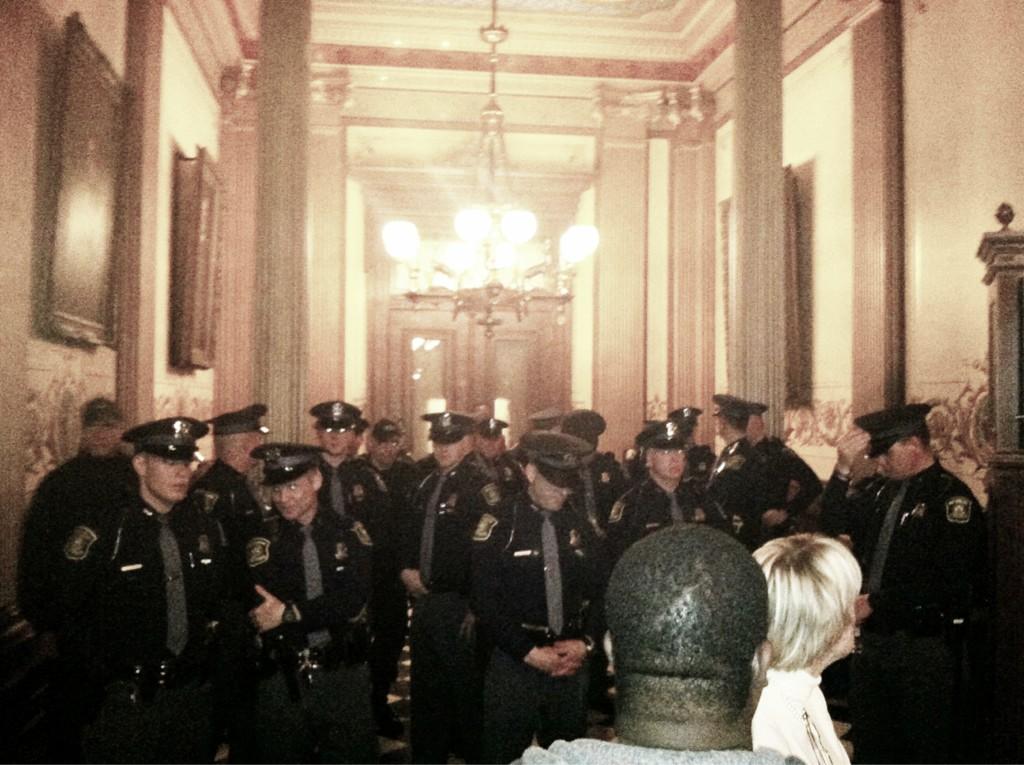10 Things to Know About What Happened in Michigan On Thursday

Photo by @PeterKlein77 on Twitter
1.) The Michigan House and Senate yesterday passed so-called “right to work” bills. “Right to work” laws effectively defund the ability of workers to have a voice at their workplace. In 23 other states, these laws have lowered wages, weakened benefits, raised the poverty rate, and led to increased workplace injuries and deaths. The House passed one such bill and the Senate passed two.
2.) Republican leaders in Michigan were not honest about their intent. The morning began with Governor Rick Snyder reversing his earlier position on the “right to work.” He had previously said that the bill was “not on his agenda,” and that it was a divisive issue – but then yesterday, he suddenly urged the House and Senate to pass the bill and said he would sign it when it reached his desk. Similarly, Senate Majority Leader Randy Richardville previously opposed “right to work,” but expressed support for it on Thursday morning.
3.) There were no committee hearings concerning the bills. With an issue this controversial, this is a highly unusual move. Republicans avoided the need for committee hearings by changing the intent of a previously passed bill.
4.) There was no floor debate concerning the bill. Another highly unusual move, considering the high profile “right to work” bill. But Republicans took advantage of their majority by ending debate on the bill before it started.
5.) 3,000 Michiganders showed up to express their opposition. Even though they only got word in the morning, there were 3,000 Michiganders at the Capitol in Lansing by 4:00pm when debate in the House was supposed to start.
6.) The public was not allowed inside the Capitol Building to observe the proceedings. Republican House Speaker Jase Bolger locked down the Capitol, locking approximately 3,000 Michiganders outside. It took a court order requested by Democrats to get the building opened again, but even then the Republican-controlled House did not pause their proceedings.
7.) Police arrested and in some cases used pepper spray on several individuals outside the building. These were Michiganders seeking to exercise their constitutional rights to assemble.
8.) The “right to work” bill is rigged so that it can’t be repealed. Republicans inserted a $1 million appropriation on the bill, which under Michigan law precludes it from being overturned by a citizen referendum. As blogger Chris Savage wrote, “not only was there no opportunity for public input before the bills were voted on, there will be none afterwards, as well.”
9.) Michigan Republicans are not unified around “right to work.” Six Republicans joined Democrats to oppose the bill in the House. It passed 58-52. In the Senate, four Republicans joined all 12 Democrats to oppose “right to work.” Furthermore, polling shows that a large majority of Michigan Republicans support collective bargaining.
10.) Time is short. Democrats put a “procedural speed bump” on moving the Senate bills to the House by one day, and there is a five-day mandatory waiting period before the House can take action.
Does all this undemocratic behavior make you mad? Us too. So here are 4 things you can do about this right now:
1.) Please join over
2.) If you are in Michigan, you can call your State Senator now using our “click-to-call” system. Even if you don’t know who your Senator is, you can enter your address and get connected to the right person
3.) Join the #SaveMI Thunderclap by connecting your Facebook and Twitter accounts to spread the message about what’s happening in Michigan.
4.) Share, post, tweet, and email your friends and family about what’s going on. Follow @WorkingAmerica and @MIAFLCIO for updates, read Chris Savage’s excellent blog, and tweet with the hashtag #SaveMI.






